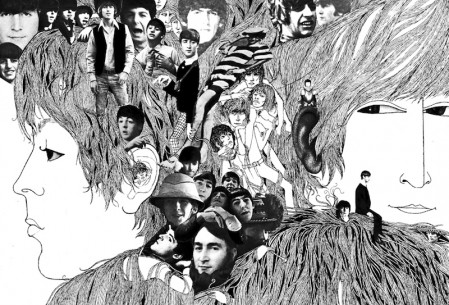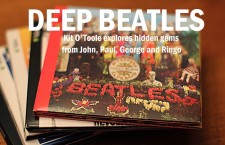
Released in America on Aug. 5, 1966, Revolver is seen by many today as the Beatles’ big-bang moment.
Over 14 wildly diverse tracks, they consolidated everything they’d mastered while leaping headlong into the experimental journeys that would soon define principal songwriters John Lennon, Paul McCartney and George Harrison. Backwards guitars, eerie sound loops, surrealist lyrics: nothing was off-limits.
In this way, Revolver tended to have little in common with the Beatles’ most recent release, 1965’s more folk-leaning Rubber Soul, but that was in keeping with their growing sense of confidence in their own muses.
Heralding the Beatles’ move from touring band to studio-based ensemble, Revolver took an astonishing 300 hours to finish – longer, it’s been said, than any rock record before it – and earned a seventh No. 1 ranking on both the American and British charts.
It got there on the strength of a double-sided No. 1 in “Eleanor Rigby / Yellow Submarine,” but there’s always been more to this endlessly satisfying masterpiece. Kit O’Toole takes us deeper into lesser-explored areas of Revolver, focusing on five key deep cuts from across the album:
‘SHE SAID, SHE SAID’
What do acid, Peter Fonda, and an argument have in common? All of these elements led to the recording of “She Said She Said,” the Revolver track known for another fact: Paul McCartney did not participate in the session. Nevertheless, “She Said She Said” stands as a classic example of the Beatles’ musical and lyrical experimentation.
Talking at a party in August 1965, Fonda told George Harrison about how he almost died at 10 years old after accidentally shooting himself in the stomach. John Lennon overheard Fonda stating “I know what it’s like to be dead”; annoyed and upset by his words, Lennon replied “You’re making me feel like I’ve never been born. Who put all that shit in your head?”
Less than a year later, the Beatles were wrapping up recording sessions for Revolver when they realized they were one song short for the final track lineup. Lennon retrieved “She Said She Said” from his song stockpile, and the group laid down the tracks for the song in a marathon nine-hour session which lasted from 7:45 p.m. until 3:45 the next morning. The Beatles rehearsed the song an astounding 25 times, then laid down the basic rhythm track in three takes. During the intense session, McCartney argued with other band members, and walked out of the studio. Harrison took over, and recording continued.
The song is structured in three parts: the main section, beginning with variations on “She said I know what it’s like to be dead”; the second occurring during two middle-eight sections, signaled by “when I was a boy,” and the final section, with the tempo increasing as Lennon and Harrison repeat the phrases “I know what it is to be sad” and “I know what it’s like to be dead.” One senses the narrator is undergoing a particularly intense experience, spinning into a chaotic and disturbing state.
When the woman protests that the narrator did not understand her, he responds that “when I was a boy, everything was right” as the key rises. As in “Help!” where John Lennon longed for a carefree past, “She Said She Said” features words describing the innocence of youth before reality descends. He would continue exploring this theme in “Strawberry Fields Forever” and “Dear Prudence.”
SOMETHING ELSE! REWIND: Click here to read more of Kit O’Toole’s look back at “She Said, She Said” from ‘Revolver‘
‘FOR NO ONE’
“Why Did It Die?” The Beatles did not write and record a song with that title — right? In truth, they did, except it was under a revised title: “For No One.” The original lyrics, while still focused on a breakdown in communication between lovers, featured even darker lyrics.
Recording began on May 9, 1966 at Abbey Road Studios; Paul McCartney played bass, piano, and clavichord (borrowed from George Martin), while Ringo Starr played drums and tambourine. Martin and McCartney decided the song needed an even more distinctive element; they subsequently selected the French horn. According to Barry Miles, McCartney hummed the melody he wanted and Martin wrote the score.
The Beatles’ daring blend of classical with contemporary sounds adds drama and sorrow to the melancholy lyrics, while Paul McCartney’s voice sounds closely miked, as if relating his story directly in the ear.
The narrator paints a picture of an aloof woman who no longer needs his love. In fact, one can argue that like “Eleanor Rigby,” this song addresses isolation, both self-imposed and unintentional. As she wakes up and “makes up” for the day, she apparently ignores the narrator, for “she no longer needs you.” He tries to reconnect, to engage her, but he sings “in her eyes you see nothing, no sign of love behind the tears.” These tears are cried “for no one,” certainly not the narrator.
The song concludes by repeating the chorus; the line “a love that should have lasted years” ends on an unresolved chord, suggesting that the narrator still cannot accept that their love is over – or perhaps that his pain is never-ending.
SOMETHING ELSE! REWIND: Click here to read more of Kit O’Toole’s look back at “For No One” from ‘Revolver‘
‘DOCTOR ROBERT
The Beatles recorded their share of mysterious tracks, such as “I am the Walrus” or even the self-parody “Glass Onion.” Critics still analyze possible meanings of “Strawberry Fields Forever” or weird experiments like “What’s the New Mary Jane.” But “Doctor Robert” continues to baffle critics and fans alike.
No matter the meaning, the song began to taken shape on April 17, 1966, when the Beatles entered Abbey Road Studios. They reentered the studio a couple of days later to record vocal tracks and oversee mono mixing. Interestingly, the original version of “Dr. Robert” featured an extended jam session, including a George Harrison solo. A section of his performance can still be heard on the mono mix, just before the first “well well well” line. Listen for the guitar to quickly fade out before the vocals kick in.
The words certainly suggest that Doctor Robert far from condemns drugs; instead, it suggests drug-taking as a way to expand one’s consciousness and seemingly operate on a higher creative plane. While one may not agree with the song’s apparent pro-drug stance, there’s no denying the Beatles’ exquisite harmonies and gritty guitar work.
When the refrain arrives, it sounds classically influenced and contrasts with the straight-ahead rock comprising most of the track. This highbrow/lowbrow comparison demonstrates John Lennon and Paul McCartney’s dry humor, that this drug supplier is somehow better and more elevated in stature than everyone else. Listen closely to Harrison, McCartney, and Lennon’s vocal blends at various points, and you’ll experience how each voice individually contributes to the song’s distinctive harmonies.
Harrison’s guitar, which cuts sharply through the track, adds a rougher edge that obviously contrasts with the chamber-music feel of the refrain. The results are lyrically complicated and harmonically sophisticated, making “Doctor Robert” one of the more underrated tracks from the milestone Revolver album.
SOMETHING ELSE! REWIND: Click here to read more of Kit O’Toole’s look back at “Doctor Robert” from ‘Revolver‘
‘I WANT TO TELL YOU’
As the Beatles’ career progressed, George Harrison gradually developed into a first-class songwriter on a par with the formidable John Lennon/Paul McCartney partnership. One of Harrison’s more unusual compositions, “I Want to Tell You,” fits in perfectly with the experimental vibe surrounding Revolver.
The pounding piano, pervasive dissonance, and a subtle reference to Harrison’s increasing interest in Indian music and culture add up to a classic and offbeat track. In 1980, Harrison described the lyrics as addressing “the avalanche of thoughts that are so hard to write down or say or transmit.” Indeed, the verses paint a picture of someone constantly struggling with language.
Harrison often found it difficult to title his songs; according to Mark Lewisohn’s The Complete Beatles Recording Sessions, the cut’s working titles included “Granny Smith,” “Laxton’s Superb” (another type of apple, foreshadowing later years) and “I Don’t Know.”
While Harrison’s lyrics are clever, the instrumentation further distinguishes “I Want to Tell You” from other rock songs of the time. The galloping piano accents the rhythm through dissonant harmonies, and Ringo Starr’s drumming easily navigates through some offbeat tempos.
As usual, the Lennon/McCartney/Harrison vocal harmonies sound tight, often singing entire lines instead of emphasizing certain words. And as with many Beatles songs, the group experiments with beginnings and endings. Similar to “Eight Days A Week,” the track gradually fades in, this time over the distinctive guitar riff.
SOMETHING ELSE! REWIND: Click here to read more of Kit O’Toole’s look back at “I Want to Tell You” from ‘Revolver‘
‘I’M ONLY SLEEPING’
While many fans believe “I’m Only Sleeping” refers to drugs, the words also refer to John Lennon’s habit of sleeping late. In his infamous interview with Maureen Cleave on March 4, 1966, the journalist mentioned that “he can sleep almost indefinitely, is probably the laziest person in England.”
Recording began on April 27, 1966, the same day that George Martin and engineer Geoff Emerick completed mono mixes of “Taxman,” “And Your Bird Can Sing,” and “Tomorrow Never Knows.” A crucial element to the track, the backwards guitar solo, followed a few days later – but then the story becomes murky.
Lennon claimed he had accidentally threaded the master tape the wrong way, resulting in the song being played backwards. Loving the sound, Lennon supposedly informed George Martin and George Harrison that he wanted to reproduce the effect in “I’m Only Sleeping.” Other accounts have Martin and/or Harrison suggesting the backwards looping.
Despite these conflicting stories, all agree that Harrison had to carefully plan and execute the solos to create the desired dreamlike effect. The lead guitarist wrote an Indian-inspired part that sounded good played backwards; next, he had to reverse the notes, then learn how to play the previous “backwards” solo normally.
In addition to these complicated effects, “I’m Only Sleeping” is notable for what would become a recurrent theme for John Lennon: dreaming. Here, Lennon answers critics like Cleave who call him lazy: He retorts that people who are “running everywhere at such a speed” are “crazy.”
In contrast, he is taking time to simply observe and enjoy diving into his dreams. For him, sleep is an escape from tedium, and it transports him to another world where he can “float up stream.” Why he feels the need for such mental excursions – the prison of fame, the grind of daily writing and recording, endless touring – is left to the listener’s imagination.
SOMETHING ELSE! REWIND: Click here to read more of Kit O’Toole’s look back at “I’m Only Sleeping” from ‘Revolver‘
- The Rescued Early Paul McCartney Song That Completed ‘Beatles For Sale’ - December 4, 2024
- A Rare Beatles Cover Proves John Lennon Was Wrong About His Voice - November 26, 2024
- How John Lennon Came Roaring Back on the Beatles’ White Album - November 22, 2023



